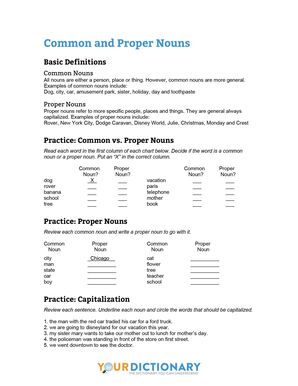

Most students learn to read and write in 1st grade. For that reason, it's vital for children to master 1st grade grammar skills in writing conventions, parts of speech and word identification. Parents and teachers alike can take a look at an overview of the Common Core-aligned key skills and concepts needed in 1st grade grammar.
Print Uppercase and Lowercase Letters
According to the Common Core state standards, students should be able to print all uppercase and lowercase letters by the end of 1st grade. Once they have mastered accuracy, 1st graders can work on keeping their writing neat and legible. Use these printable alphabet letters worksheets to help 1st graders practice their printing.
Common, Proper and Possessive Nouns
First graders continue their study of parts of speech with common nouns, as well as proper and possessive nouns. They can work on distinguishing between common and proper nouns, capitalizing proper nouns correctly, and using possessive nouns in context. Try out these common and proper noun exercises in the classroom or for extra practice at home.

Basic Subject-Verb Agreement
Using singular and plural nouns in a sentence is an important 1st grade skill. Adding an extra challenge to this concept is matching a verb correctly to its noun, which is the beginning of subject-verb agreement. Practice this important grammar skill with a helpful subject-verb agreement worksheet.

Elementary subject verb agreement worksheet
Click to View & DownloadPersonal, Possessive and Indefinite Pronouns
First graders focus on mastering personal pronouns, such as I, you, he, she, or it. Once they have met that challenge, 1st graders can work on possessive and indefinite pronouns. Check out a worksheet on possessive pronouns to reinforce skills. If 1st graders are ready, give them these additional indefinite pronoun exercises.
Past, Present and Future Tense Verbs
Once 1st graders know the difference between nouns and verbs, they can learn the different verb tenses. They should know how to convey a sense of time with past, present and future tense verbs by the end of the school year. For more practice with this skill, check out a helpful verbs worksheet about all three tenses.
Adjectives, Conjunctions, Determiners, Prepositions
There are a few more parts of speech that are included in grammar topics for 1st grade. They include frequently occurring:
- adjectives (happy, sad, orange)
- conjunctions (and, but, because)
- articles (a, an, the)
- demonstratives (this, that, these, those)
- prepositions (on, of, toward)
Once 1st graders can identify these parts of speech, they can build more complex sentences. Get more practice with an adjectives worksheet for classroom or homework. Additionally, 1st graders can work on an elementary conjunctions assignment to reinforce these important parts of speech.
Simple and Compound Sentences
By the end of 1st grade, students should be able to produce simple and compound sentences. These sentences should include the following types:
Beginning writers who are still working on simple sentences can work on combining these sentences with conjunctions. Use these sentence combining worksheets to help students turn their simple sentences into compound sentences.
Capitalize Dates and Names of People
First graders who are new to the concept of capitalization can focus on two simple skills. They can work on capitalizing dates when describing days of the week and months of the year. Also, 1st graders should know how to capitalize names of people. Practice both skills with a helpful 1st grade capitalization worksheet.
End Punctuation
Now that 1st graders know how to write different types of sentences, they can punctuate them correctly. First graders are expected to know the proper punctuation for each type of sentence. Reinforce the rules of punctuation with 1st graders in your next grammar lesson.
Commas in Dates and Series of Words
At the end of 1st grade, students should have a solid understanding of comma usage. The Common Core state standards for 1st grade details two key skills in this area:
- adding commas to dates (for example: January 1, 2020)
- adding commas to a series of words (for example: cats, dogs, and bunnies).
Focus on these specific concepts so that 1st graders are ready for more complex skills later on.
Memory and Phonetic Spelling
In kindergarten, students are encouraged to spell words based on how the sound. But 1st grade gets more challenging when it comes to spelling. First graders should be able to use conventional spelling for frequently occurring regular and irregular words, and apply phonemic awareness to new words. For more spelling practice, use these free spelling printables in class or at home.
Context Clues
As 1st graders learn to read, they will encounter many unfamiliar words. Using context clues is an effective way for 1st grades to both understand what they are reading and add to their personal vocabulary. This skill starts in 1st grade but is applicable to all elementary, middle and high school grades.
Frequently Occurring Root Words
First graders should also be able to identify frequently occurring root words and their conjugated forms. For example, if they read the word walk, they should also know the word walks, walking and walked. Use a list of regular verbs to ensure that 1st graders can perform this skill.

Regular verbs list
Click to View & DownloadCategorize Similar Words
First grade grammar standards identify the need for students to categorize words by similar attributes. For example, 1st graders should be able to put chicken, horse and cow in a category for farm animals. In addition, students should define words by both their category and a key attribute of that word.
Make Real-Life Connections Between Words
First graders learn many new words during the school year. Making real-life connections to these words helps students apply them properly. For example, when 1st graders learn the word read, they should think of things that they can read, such as posters, books and signs.
Distinguishing Words
Higher-level readers in 1st grade can grasp word nuance easily. However, the Common Core state standards expect that all students should distinguish between:
- verbs differing in manner (speak, yell, scream)
- adjectives differing in intensity (small, little, tiny)
As in most standards, these skills are best taught with lots and lots of reading. Point out word nuance in picture books and short stories to demonstrate strong reading skills.
Keep It Fun
In the first grade, kids are primed to learn about language. They love to talk and sing and do all the things that language empowers them to do. Keep learning fun with these engaging grammar games that are adaptable for all grade levels and classrooms.